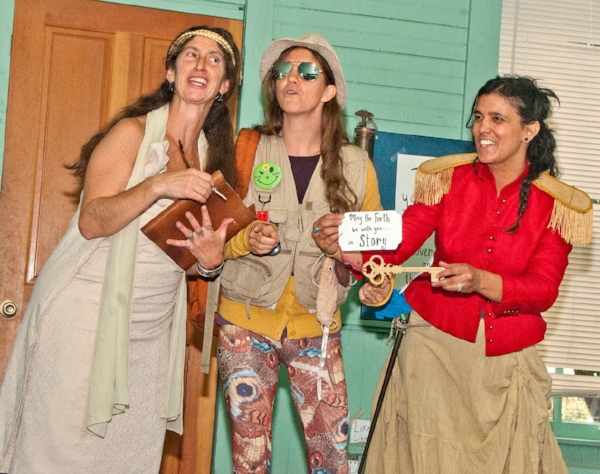By Arlene Goldbard, Chief Policy Wonk
This is the fourth in a series of blogs profiling the USDAC’s Policy Prototype projects, seven projects across the U.S. receiving micro-grants to document their work related to the proposals in “Standing for Cultural Democracy: The USDAC’s Policy and Action Platform.”
Cristina Cabeza Kinney’s Policy Prototype proposal called for a “Belonging Bandwagon” project in Crestone, a tiny town in southern Colorado best-known for the large number of Buddhist, Hindu, and other spiritual centers in the area. Speaking to Platform point 5—Invest in Belonging and Cultural Citizenship and Platform point 8—Adopt a Cultural Impact Study—Cristina highlighted the challenges of collaboration between Crestone, a municipality of around 150 residents, home to the commercial district serving the whole area including the much larger adjacent Baca Grande subdivision with about 2000 residents, managed by a homeowner’s association.
In her proposal, Cristina explained that cultural organizing in these communities means going directly to the people: “As a Planning Commissioner, I know no one wants to go to meetings and hardly anyone does. So, we go to where they are: Saturday market, the cafe, the plaza, poetry readings, theatre productions, meetings, the school. Develop the culture by engaging it.”
Partnering with the theatrical group Company of Players, Crestone Town Board of Trustees, Crestone Creative District, Awakening The Phoenix, and Blue Earth Design, engage it they did—with a spirit of wildly performative fun. Cristina and other core Belonging Bandwagon team members took on the role of time-traveling “exploradoras” embodying an aspect of cultural inquiry: Juana Azurduy, a Bolivian guerilla leader (Cristina Cabeza-Kinney), Harriet the Falconer (Kelly Hosner Crowley) and the poet Sappho (Allison Wonderland), all three characters previously featured in the Company of Players production Herstories).
A sketch for the belonging bandwagon, a movable repository for stories, resources for making things, and printed information.
In the performance, audience members learned that the three explorers “fell down through the Charter Portal as we were summoned to Crestone by local story weavers…. As we prepared to travel back up through the portal, while shaking our heads and waving our farewells, we discovered the portal was shut to us. Anti-gravity aerodynamic lift interference with spacetime tessering entanglement, apparently...obviously. Just then a grand voice boomed saying, ‘To find your way through, you must work to include, discover the clues and fill the bandwagon with home.’” Clues came in the form of interactions with locals and a set of keys that magically appeared, each unlocking a different aspect of belonging.
Juana told the audience that “we discovered that the common theme in all of these key clues is STORY! We then wondered what are the actual stories of culture and belonging of the people who live in this village of Crestone? And this is what has brought us here today to be with you!” After collecting stories from audience members, the trio invited everyone into Story Circles to help design the Belonging Bandwagon, a multi-purpose wooden structure on wheels; to populate the Crestone-Baca Sense of Belonging Book, one of many artifacts the Bandwagon would hold; and to consider ideas such as the Policy on Belonging and Cultural Impact Study, putting humanity into policy.
Cristina expressed the hope that the Policy on Belonging could speak to all community members. “What I love about the Policy on Belonging,” she said, “is that it's this universal thing to hold it all in. Some of the spiritual centers have supported the project, and I can see them adopting a Policy on Belonging. So it's gaining some traction.”
The Crestone-Baca Belonging Bandwagon was conceived as a repository for all the explorers had learned, all the stories community members had shared, and the sense of home beginning to take shape and expand. “That's really what it’s about,” Cristina told me, “people sharing the history, sharing their point-of-view, and putting it on the Bandwagon so we can have that as a cultural artifact for future generations as a motivation.”
The team made a wonderful short video that begins with the initial performance at the community’s annual Fourth of July parade. It sums up the exploradoras’ learning: “The trio discovered that our sense of belonging is strong, yet our sense of democracy is splintered, which contributes to a pestering dis-belonging and a lingering mistrust.”
Sappho, Harriet The Falcolner, and Juana Azurduy exploring with the people of Crestone-Baca.
The physical setting is part of the challenge. Saguache County encompasses quite a bit of land—more than 3,000 square miles—but the population density is low, with only 6,000 or so residents. There’s a progressive community of mostly relative newcomers; a longstanding agricultural community; and the fact that countywide, close to half the residents are Latinx, but demographics in the subdivision do not reflect that, especially considering that many of the dwellings are vacation homes occupied only part of the year. A further obstacle to engaging people in policy conversations was a pervasive skepticism about government. “Mistrust was the elephant in the room that needed to be addressed,” Cristina explained. “Listening was really important when engaging with the community. Going to different groups really showed us that sense of mistrust, because everything was fine when it was all about art, but when we grounded it in actual policy change, it all came up.”
Responding to mistrust of public policy caused the project to slow its pace a bit. “I wanted to listen to the resistance,” Cristina explained. “Instead of fighting the resistance, just allowing it to be what it was. We needed to go back to ground zero and really start with value. We're coming from every direction on the planet to live in this place, mostly with no roots of ancestral belonging, and we need to start at square one, which is our values. And luckily the USDAC's values that we've been working with this year, it's great we have that.”
After the performative phase of the project, the team showed the video to the Town of Crestone leadership, presenting 25 letters of interest from local folks who wanted more engagement in community and belonging, and offered the Cultural Impact Study as a model Crestone might adopt. They also began conversations about bringing the same issues and policies to the Baca Grande Property Owners’ Association, where two members of the core team live.
Cristina emphasized that projects like these are emergent, not following a precise blueprint. “You need to pay attention to where it wants to lead, where it wants to go, to really cultivate the listening and be comfortable with being uncomfortable or at least tolerant of being uncomfortable.” Starting out, she had an idea of how it would go. But, “there was such an influx of so many people wanting to meet in groups. They just popped up everywhere. A lot of the year I was just trying to keep that perspective of taking it all in and letting it play out. So we didn't have to prod too much, we didn't have to really go into much community organizing. It really popped this year with Trump becoming the President.”
Crestone was one of the first communities to become a USDAC outpost. Holding a successful Story Circle event for the People’s State of the Union had introduced people to arts-based participatory methods of civic engagement, and that helped to involve people in the Belonging Bandwagon project. “The Story Circles are really important,” said Cristina. “We had great feedback after the People's State of the Union. I want to do more Story Circles around belonging. I would love to host a series with first listening together and then having a Story Circle afterwards.”
Offering advice for others who want to explore similar policy territory, Cristina urged people to consider using a performative frame as Crestone did. “The performance art piece has a lot of potential to engage from a neutral, outside point-of-view and really have fun with exploring. As a pilot project, that's a really important piece. Of course, every individual community will interpret that in their own way and have to listen to their own community, but this idea of explorers from another space and time coming and unearthing what's happening in a community is really beautiful. They left our community a gift, with the ball in the community's court after the performance. Where's the community going to take it from there?”
If you’d like to explore bringing any points in Standing for Cultural Democracy to life in your community, please feel free to contact us at hello@usdac.us. While Policy Prototype micro-grants were a one-time thing, we can still offer technical assistance and help share information with the wider world if you have a project that promotes one of more of the Platform points, so call on us.


